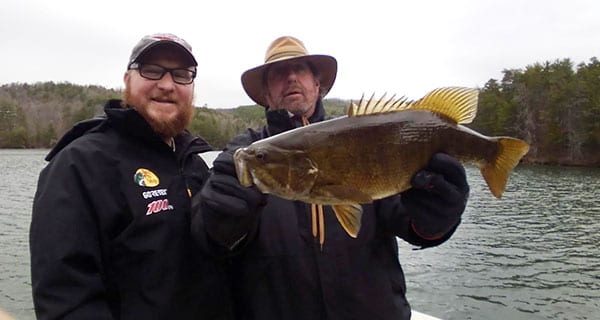I am excited to be writing again after a month away (last month’s deadline snuck up on me, and I missed it due to a trip to the Charleston area). I am also enthusiastic about the cooler temperatures we’ve started experiencing this week (mid-October), and they have got me thinking about one of my favorite things on earth: the late fall/winter smallmouth bite.
While the invasion and takeover of the spotted bass has almost eradicated the smallmouth from many of its traditional waters in the western part of North Carolina, we are blessed to still have them in abundance in our area (as long as the spots are kept somewhat under control), and the absolute best time to fish for them is in the winter. In fact, while we catch smallmouth year round, the November-March timeframe is inarguably and definitively the best time to pursue them, for a number of reasons.
One of the primary reasons I enjoy pursuing smallmouth this time of year is because they are a cold water species to start with, and their metabolism is not as severely impacted by cooler water temps as, say, a largemouth would be. In fact, they can be impressively aggressive until the water dips below 40 or so degrees, far below what many of our other local species find comfortable. Another reason I love this time of year is that smallmouth are at their physical heaviest and healthiest this time of year, which means not only do they weigh more, but they are easier to release. As many of you know, my trips are 100 percent catch and release on all largemouth and smallmouth bass, and cold water makes these fish much hardier and tougher than high water temperatures.

Weather can play a pivotal role in this style of fishing, so what are “perfect” weather conditions for pursuing smallmouth this time of year? A perfect day would be a cold, overcast, calm day; one where you think it could start snowing at any time. For some reason, the super low barometric pressure that accompanies that type of weather seems to really intensify the smallmouth bite. A close second would be a warmer-than-average, somewhat choppy, day with big puffy clouds. That tends to draw the fish up in the water column, as they can sense that warmer surface layer, but the wind and barometric pressure are not too high to spook them. The worst conditions are exceptionally cold, windy, no cloud in the sky, “bluebird” days. You can and will still catch fish in those conditions, but you will have to work harder for them.
If you would like to learn more about winter locations, tactics, and lure/bait selection for winter smallmouth, or just want to put a bunch of them in the boat, you can book a trip with me by calling 865-466-1345. I would love to spend a winter day on the lake with you fishing for one of the finest gamefish that swims.
Aaron Kephart is the Owner of Mountain Lakes Guide Service. To book a guided trip on one of the Murphy area mountain lakes, contact him by phone or by email at mtnlakesguide@outlook.com Checkout his website at http://www.mtnlakesguideservice.com and catch him on facebook@mountainlakesguideservice
